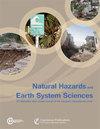火灾风险建模:应用于西西里岛的综合数据驱动方法
IF 4.7
2区 地球科学
Q1 GEOSCIENCES, MULTIDISCIPLINARY
引用次数: 0
摘要
摘要野火不仅是景观改造和植被演替的关键,也是社会生态价值损失的关键。火灾风险地图可以帮助管理受野火影响的最脆弱和最相关的生态系统。然而,很少有研究在不同的时空尺度上提供可访问的日常动态结果。我们为地中海盆地的标志性案例西西里岛(意大利)开发了一个火灾风险模型,将火灾危险模型与当前和未来条件下的暴露和脆弱性分析相结合。集成模型是数据驱动的,但可以在每天的时间步长动态运行,通过k.LAB(知识实验室)软件提供空间和时间上明确的结果。该软件为输入数据集成提供了一个环境,结合了地理信息系统、遥感和贝叶斯网络算法等方法和数据。所有数据和模型都经过语义注释、开放和可下载,符合FAIR原则(可查找、可访问、可互操作和可重用)。火灾风险分析显示,45 % 西西里岛脆弱地区2050年发生火灾的可能性很高。风险模型输出还包括定性风险指数,这可以使非技术利益相关者更容易理解结果。我们认为,在当前和气候变化的条件下,这种方法非常适合帮助景观和火灾风险管理。本文章由计算机程序翻译,如有差异,请以英文原文为准。
Fire risk modeling: an integrated and data-driven approach applied to Sicily
Abstract. Wildfires are key not only to landscape transformation and vegetation succession, but also to socio-ecological values loss. Fire risk mapping can help to manage the most vulnerable and relevant ecosystems impacted by wildfires. However, few studies provide accessible daily dynamic results at different spatio-temporal scales. We develop a fire risk model for Sicily (Italy), an iconic case of the Mediterranean Basin, integrating a fire hazard model with an exposure and vulnerability analysis under present and future conditions. The integrated model is data-driven but can run dynamically at a daily time step, providing spatially and temporally explicit results through the k.LAB (Knowledge Laboratory) software. This software provides an environment for input data integration, combining methods and data such as geographic information systems, remote sensing and Bayesian network algorithms. All data and models are semantically annotated, open and downloadable in agreement with the FAIR principles (findable, accessible, interoperable and reusable). The fire risk analysis reveals that 45 % of vulnerable areas of Sicily have a high probability of fire occurrence in 2050. The risk model outputs also
include qualitative risk indexes, which can make the results more understandable for non-technical stakeholders. We argue that this approach
is well suited to aiding in landscape and fire risk management, under both
current and climate change conditions.
求助全文
通过发布文献求助,成功后即可免费获取论文全文。
去求助
来源期刊
CiteScore
7.60
自引率
6.50%
发文量
192
审稿时长
3.8 months
期刊介绍:
Natural Hazards and Earth System Sciences (NHESS) is an interdisciplinary and international journal dedicated to the public discussion and open-access publication of high-quality studies and original research on natural hazards and their consequences. Embracing a holistic Earth system science approach, NHESS serves a wide and diverse community of research scientists, practitioners, and decision makers concerned with detection of natural hazards, monitoring and modelling, vulnerability and risk assessment, and the design and implementation of mitigation and adaptation strategies, including economical, societal, and educational aspects.

 求助内容:
求助内容: 应助结果提醒方式:
应助结果提醒方式:


